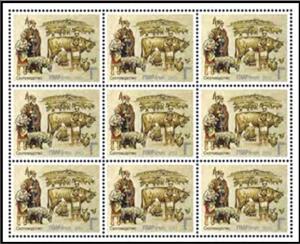Full Pane: Cattle Breeding (Transnistria 2012)
Cattle Breeding (Transnistria 2012)
02 May (Transnistria ) within release History of Transnistria (II) - Slavs goes into circulation Full Pane Cattle Breeding face value 9*Г No Face Value
| Full Pane Cattle Breeding in catalogues | |
|---|---|
| Colnect codes: | Col: MD-PMR 2012.05.02-12a |
Full Pane is horizontal format.
Also in the issue History of Transnistria (II) - Slavs:
- Full Pane - Agriculture face value 9*Д;
- Full Pane - Cattle Breeding face value 9*Г;
- Full Pane - History of Transnistria (II) - Slavs face value Р,Т,Д,Г,К;
- Full Pane - Hunting face value 9*T;
- Full Pane - Iron Production face value 9*K;
- Full Pane - Pottery face value 9*K;
- Mini Sheet - Wood Processing face value 3*P;
Full Pane Cattle Breeding it reflects the thematic directions:
Animals are multicellular, eukaryotic organisms of the kingdom Animalia (also called Metazoa). All animals are motile, meaning they can move spontaneously and independently, at some point in their lives. Their body plan eventually becomes fixed as they develop, although some undergo a process of metamorphosis later on in their lives. All animals are heterotrophs: they must ingest other organisms or their products for sustenance.
Cattle (Bos taurus) are large, domesticated, bovid ungulates widely kept as livestock. They are prominent modern members of the subfamily Bovinae and the most widespread species of the genus Bos. Mature female cattle are called cows and mature male cattle are bulls. Young female cattle are called heifers, young male cattle are oxen or bullocks, and castrated male cattle are known as steers.
Sheep (pl.: sheep) or domestic sheep (Ovis aries) are a domesticated, ruminant mammal typically kept as livestock. Although the term sheep can apply to other species in the genus Ovis, in everyday usage it almost always refers to domesticated sheep. Like all ruminants, sheep are members of the order Artiodactyla, the even-toed ungulates. Numbering a little over one billion, domestic sheep are also the most numerous species of sheep. An adult female is referred to as a ewe (/juː/ yoo), an intact male as a ram, occasionally a tup, a castrated male as a wether, and a young sheep as a lamb.



